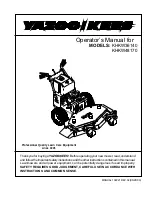
10
S
ection
2 — A
SSembly
& S
et
-U
p
To move the seat forward or back, locate the
seat adjustment rod under the seat. Push the
rod to the left and slide the seat forward or
back into the desired position and release the
rod when the seat is in the desired position.
See Figure 2-4.
Figure 2-4
To adjust the arm rest, lift the arm rest and
rotate the block adjustment into one of the
four positions (0-3, 0 being the lowest and 3
being the highest.) and lower the arm rest. See
Figure 2-5.
Figure 2-5
The mechanical suspension mechanism (if
equipped) incorporates weight/ride adjustment
controls for operators in the 125 to 275 lb. weight
range (turn the knob on the front of the seat
clockwise to increase the weight capacity and
counter-clockwise to decrease. See Figure 2-6.
Figure 2-6
NOTE:
The seat base must be secured by the
latch, otherwise, the seat assembly could tilt
forward. The Operator Presence Sensor must
be connected to the electrical wiring harness.
Connecting the Battery Cables
CALIFORNIA
PROPOSITION 65
WARNING
! Battery posts,
terminals, and related
accessories contain lead and lead
compounds, chemicals known to
the State of California to cause
cancer and reproductive harm.
Wash hands after handling.
CAUTION:
When attaching
battery cables, always connect
the POSITIVE (Red) wire to its
terminal first, followed by the
NEGATIVE (Black) wire.
For shipping reasons, both battery cables on your
equipment may have been left disconnected
from the terminals at the factory. To connect the
battery cables, proceed as follows:
NOTE:
The positive battery terminal is marked
Pos. (+). The negative battery terminal is
marked Neg. (–).
NOTE:
If the positive battery cable is
already attached, skip ahead to step 2.
1.
Remove the plastic cover, if present, from
the positive battery terminal and attach
the red cable to the positive battery
terminal (+) with the bolt (a) and hex nut
(b). See Figure 2-7.
(b)
(b)
(a)
(a)
(c)
Figure 2-7
2.
Remove the plastic cover, if present, from
the negative battery terminal and attach
the black cable to the negative battery
terminal (–) with the bolt (a) and hex nut (b).
See Figure 2-7.
3.
Position the red rubber boot (c) over the
positive battery terminal to help protect
it from corrosion.
NOTE:
If the battery is put into service
after the date shown on top/side of
battery, charge the battery as instructed in
“Charging the Battery” on page 23 prior
to operating the tractor.
Transmission Oil Expansion Reservoir
The transmission oil expansion reservoir
is connected by hoses to the RH and LH
transmission assemblies, and is located behind
the seat box. The function of the reservoir is
to hold the natural expansion of transmission
oil that occurs as the transmission warms up
during operation. DO NOT FILL THE RESERVOIR.
Under normal operating conditions, no oil
should be added to the reservoir. The COLD oil
level should be no higher than approximately
1⁄4” (the “Full Cold” mark) above the bottom of
the reservoir. See Figure 2-8.
Figure 2-8
NOTE:
Prior to the initial operation of the
tractor, the oil level in the reservoir may be
slightly higher than the maximum due to air
in the oil lines. Operation of the tractor will
eventually purge the air from the lines and the
oil level will settle to the maximum.
Install the Rear Hitch Bracket (If
necessary)
1.
Remove the hex flange screws (a) and
flange lock nuts (b) that secure the
hitch bracket (c) to the bumper bracket.
See Figure 2-9.
a
b
a
b
a
b
c
Figure 2-9
2.
Install the hitch bracket (c) as shown
in Figure 2-10 and secure with the hex
flange screws (a) and flange lock nuts (b)
removed in step 1.
a
b
a
b
a
b
c
Figure 2-10
Summary of Contents for Pro Z 100 Lapbar
Page 27: ...Notes 27 8 ...











































